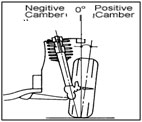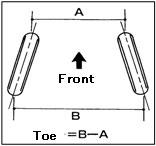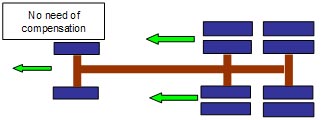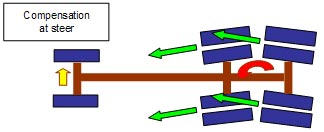Wheel alignment
Wheel alignment is widely known as camber, caster and toe in or toe out. if it is not properly maintained, tires are likely to face irregular wear or rapid wear problem.
| * Camber |
 |
 Camber is the inclination of the wheel from the top of the wheel, measured in degrees. If the camber is out of tolerance, it will cause tire wear on one side of the tread. Excessive Camber is the inclination of the wheel from the top of the wheel, measured in degrees. If the camber is out of tolerance, it will cause tire wear on one side of the tread. Excessive |
| * Caste |
 |
Caster is the forward or backward inclination of the kingpin in the pivot which is installed at both end of steering linkage.
Caster is positive, if the top of the king pin tilts backward toward the rear of the vehicle. Although caster has little affecton tire wear, but is important in the steering and drivability of the vehicle.
|
| * Toe in/out |
 |
 Toe setting greatly affects tire wear. The toe is measured by the difference in the distance between the front tires and the back ones. If the toe "B-A" shown in the chart is positive, it is toe inand if the toe is negative, it is toe-out. The toe is usually set in the positive side, which means that setting is usually toe-in. It is measured in mm and set between approximately 0 to 5mm. At high toe-in or toe-out condition, the tread of outside or inside area can becompletely worn down in a typical feather edge wear pattern. Toe setting greatly affects tire wear. The toe is measured by the difference in the distance between the front tires and the back ones. If the toe "B-A" shown in the chart is positive, it is toe inand if the toe is negative, it is toe-out. The toe is usually set in the positive side, which means that setting is usually toe-in. It is measured in mm and set between approximately 0 to 5mm. At high toe-in or toe-out condition, the tread of outside or inside area can becompletely worn down in a typical feather edge wear pattern.
|
Suspension geometry
Suspension geometry largely affects the tire wear.
 |
If the tires in front and drive axle are in line and parallel to chassis, drive tires push forward the vehicle in line with the direction of chassis.
The vehicle runs straight without steering.
Therefore there is no side force applied to the tires and wear normally.
|
 |
If the drive axles are paralleled ,but not perpendicular to the chassis center line, the drive tires generates thrust to the left at the rear of the truck. If the vehicle tries to run straight, this thrust must be compensated by steering to the left.
Even though lateral force on the steer tires are minimal, which may result in asymmetrical steer tire wear, because the side force is always applied while running straight.
|
 |
If the drive axles are neither parallel each other nor perpendicular to the chassis centerline.
Thedrive axle tires are trying to force the vehicle to turn left and the driver must compensate by turning to the right.
This will result in fast and irregular wear.
|